The Mediterranean island nation of Malta is small. There are many surprises and intriguing aspects of its culture and history. Malta’s stunning scenery and historic sites are well known, but there is still more to explore.Let’s explore 25 fun facts about Malta that might surprise you.
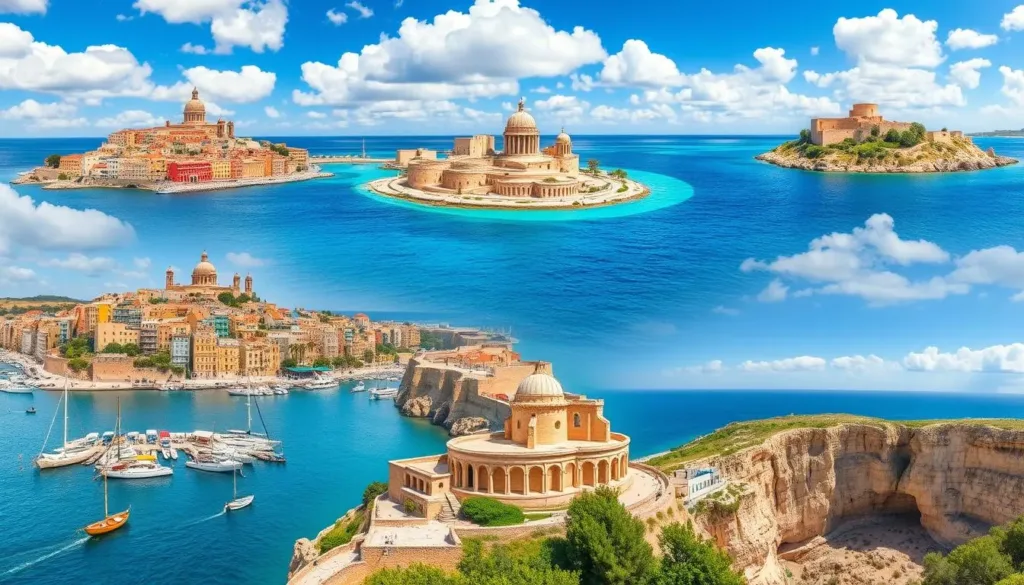
A vibrant collage of Malta’s iconic landmarks, featuring the colorful buildings of Valletta, the azure waters of the Blue Lagoon, ancient Megalithic temples, picturesque fishing villages with traditional luzzu boats, and the stunning cliffs of Dingli, all set against a bright blue sky with fluffy clouds and lush greenery.
Also Read:- Indian Passport Visa-Free Countries: How Many Countries Can Indians Travel Without a Visa in 2023–2024
Key Takeaways
- Predating even the ancient Egyptian pyramids, Malta is home to some of the world’s oldest free-standing buildings.
- The Maltese language is one of the most distinctive in Europe due to its unique fusion of Romance and Semitic influences.
- Malta was an essential foothold for the Allied forces in the Mediterranean during World War II.
- The Knights of Malta have a long history in the island nation, and their architectural and cultural contributions are evident all over the place.
- Malta boasts a booming film industry despite its tiny size, providing the scene for many popular television series and Hollywood blockbusters.
Ancient History and Megalithic Temples of Malta
Prior to the construction of the pyramids and Stonehenge, Malta’s history dates back to 3600 BC. Incredible megalithic temples can be found on the islands. These demonstrate Malta’s ancient inhabitants’ talent and inventiveness.
Temples Older Than Stonehenge
Among the oldest structures in the world are the megalithic temples. They were constructed from massive stones, some of which weighed tons. An ancient wonder, they are more than a thousand years older than Stonehenge.
Archaeological Significance
- We can see a glimpse of Malta’s ancient society and culture through the temples.
- Archaeologists have discovered a lot of items. We can better comprehend the beliefs and lifestyles of the ancient people thanks to this.
- The designs of the temples, such as the alignments and sculptures, continue to astound scholars and tourists.
UNESCO World Heritage Status
In 1980, Malta’s megalithic temples were designated as a UNESCO World Heritage Site. Their significance to history and culture is demonstrated by this. It also emphasizes the necessity of protecting them going forward.
“The Malta megalithic monuments are an amazing example of our predecessors’ inventiveness and tenacity. Thousands of years old, these structures never cease to enthrall and motivate anybody who sees them.
Malta’s Unique Position in World War II
Malta was important in the Mediterranean during World War II. It was a little island that was fortified. Because of its location, it was essential to the Allies.
Malta’s defenses, which date back to the 16th-century Great Siege of Malta, enabled it to repel Axis assaults.
Malta was resilient in the face of the Axis. It was subjected to constant naval blockades and air raids. They dubbed it “the most bombed place on Earth.”
In spite of this, the Maltese and their allies resisted. In the Mediterranean, they prevented the Axis from gaining ground.
The island needed to be fortified. It featured gun emplacements, anti-aircraft batteries, and tunnels beneath the ground. Because of these, the Allies were able to assault the Axis again.
The bravery and resourcefulness of the Maltese people made Malta a formidable barrier. The Axis was unable to defeat it.
“Malta was the hinge of the war. If Malta had fell, the Axis powers would have controlled the entire Mediterranean.” – Sir Winston Churchill
The war was won by the Allies thanks to Malta’s defense. It was a representation of tenacity and bravery due to its spirit and strategic significance.
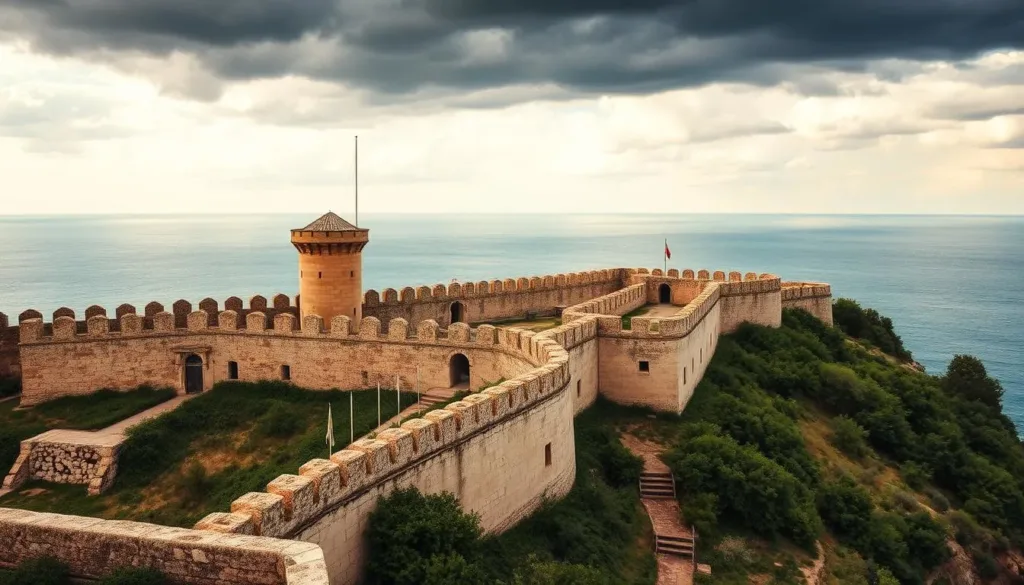
A historic Maltese stronghold that highlights the strategic military architecture of World War II, featuring strong limestone walls and old watchtowers, surrounded by lush Mediterranean greenery, and the sea in the distance under a dramatic sky.
The Fascinating Language and Cultural Heritage
Malta’s language and rich cultural legacy reflect its multiculturalism. The Maltese language reflects the diverse history of the island. Its Semitic ancestry reflects the island’s varied history.
Origins of Maltese Language
Prior to Christ, the Phoenicians were the first to speak Maltese. It merged with numerous cultures over time, including Arab, Roman, and Greek. The identity of Malta is shaped by this mixture.
- Although it is written in the Latin script, the Maltese language is Semitic and closely linked to Arabic.
- It is the only European Union official language that is not Indo-European and the only Semitic language written in Latin script.
Cultural Influences Through History
Malta was a melting pot of civilizations due to its Mediterranean position. The impact of colonial empires and ancient civilizations is evident. This mixture gives Malta its distinct culture..
- The prehistoric temples on the island, some of which predate Stonehenge, demonstrate the Maltese civilization’s long history.
- Cities and towns on the island display the architectural styles of the Italians, British, and Knights of St. John.
- Over the ages, Malta has been influenced by many different civilizations, which have molded its traditions, customs, and food.
Modern Linguistic Evolution
The Maltese language continues to evolve in the modern era, reflecting the times and emerging cultural trends. While retaining its Semitic roots, it also incorporates English, Italian, and other contemporary languages. This makes it a distinctive and engaging mode of communication.
The flexibility of the Maltese language demonstrates the tenacity of the Maltese people. By embracing their varied heritage, they have developed a distinct identity. This distinguishes them from their neighbors.
Fun Facts About Malta That Will Surprise You
Malta is a small Mediterranean island nation that is full of surprises. There is more to it than meets the eye. Allow me to present some intriguing facts that may surprise you.
The only Semitic language written in the Latin alphabet is Maltese, the national language of Malta. Did you know that? This distinctive linguistic legacy demonstrates the various cultural influences that Malta has experienced over the ages.
Gozo, Comino, and Malta are the three main islands that make up Malta, which is another unexpected truth. The largest and most populated is Malta, but Gozo is renowned for its breathtaking scenery and easygoing charm. What about Comino? It’s a little island without cars that is a haven for nature lovers.
Due to the island’s history of British colonization, driving in Malta is done on the left side of the road, which may surprise you. In order to traverse Malta’s twisting streets, tourists from nations where driving is done on the right side of the road will need to swiftly adjust.
| Fact | Surprise |
|---|---|
| Maltese is the only Semitic language written in Latin script | Malta’s unique linguistic heritage |
| Malta consists of three main islands: Malta, Gozo, and Comino | The diversity of Malta’s geography |
| Malta drives on the left-hand side of the road | A legacy of Malta’s British colonial past |
Here are just few of the amazing facts that contribute to Malta’s allure and distinctiveness as a travel destination. Remember to have an open mind and be ready for pleasant surprises as you travel throughout this island nation.
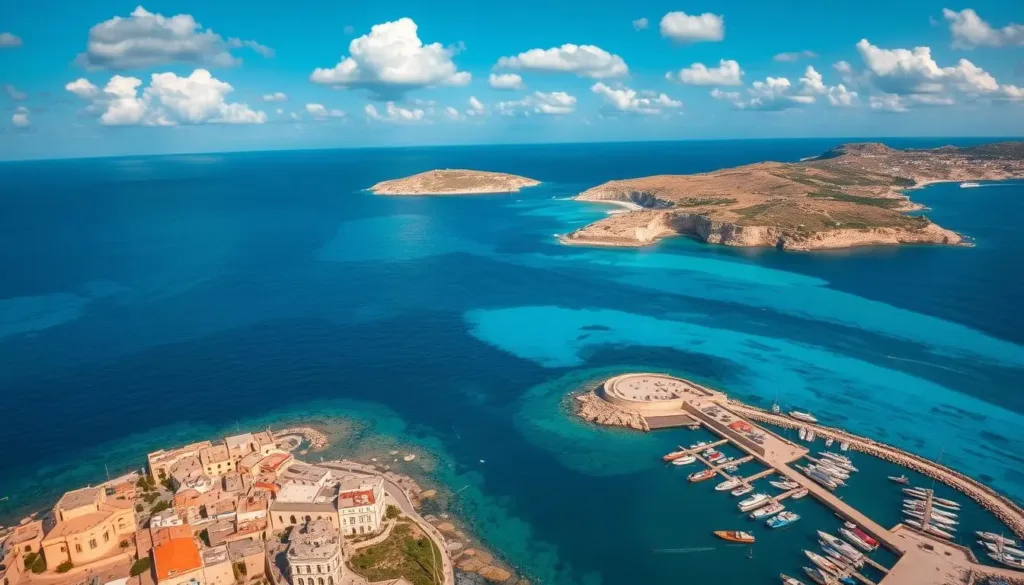
The breathtaking Maltese islands are seen from above, with their rocky coastlines, turquoise waters, and vibrant Mediterranean vegetation; traditional stone buildings with earthy tones, historic fortifications, and quaint harbors with colorful fishing boats, all set against a brilliant blue sky speckled with fluffy white clouds.
Hollywood’s Love Affair with Malta’s Landscapes
Hollywood has long been captivated by Malta’s breathtaking scenery. Several well-known movies and television series have been filmed in this Mediterranean country. Filmmakers now choose it as their first option.
Famous Movies Filmed in Malta
Many films have featured Malta’s diverse scenery. The azure waters of The azure Lagoon and the remains of Gladiator are just two examples. Its buildings and cliffs give historical drama to movies, and its coves and harbors make for romantic settings.
- Gladiator (2000)
- The Count of Monte Cristo (2002)
- World War Z (2013)
- The Da Vinci Code (2006)
- Troy (2004)
Game of Thrones Connection
Malta plays a particularly significant part in Game of Thrones. Westeros was shaped in part by its rugged landscapes and medieval structures. Here, several important sequences were filmed.
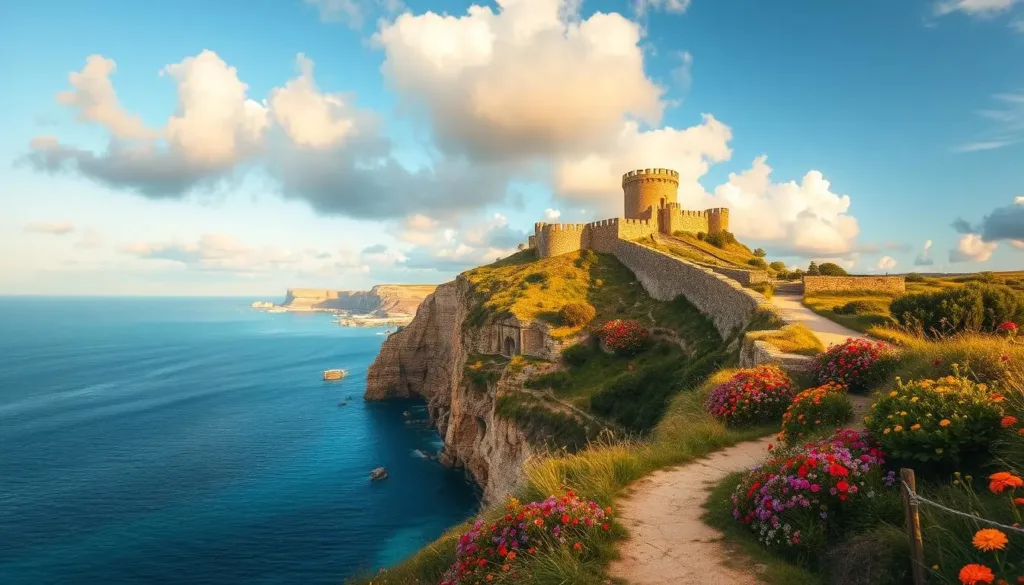
Malta’s breathtaking scenery, with its steep cliffs and antique buildings that evoke a fantasy world, is illuminated by golden sunlight. With its expansive coastline, azure oceans, crumbling stone defenses, and verdant surroundings, the scene evokes the enchanted ambiance of a medieval kingdom. A castle on a hill is reached in the foreground by a meandering route, with colorful wildflowers swaying in the light wind. A hint of an epic quest is given by the soft clouds painting the sky.
The streets and fortifications of Malta were used in Pentos and King’s Landing. Its distinctive qualities have led to its inclusion in Game of Thrones. This has increased curiosity about Malta’s appearance in TV shows and films.
Traditional Maltese Food and Culinary Secrets
Malta’s diverse culture is reflected in its cuisine. It features a variety of Mediterranean flavors and delicacies that highlight Maltese culture.
The pasta is quite popular in Malta. Ricotta or peas are the filling for these light pastries. They pair well with either coffee or tea.
Maltese bakers take pride in their custom. They have years of experience producing pastries.
An other favorite is the qassatat. It’s an olive, spinach, and anchovie pie. It demonstrates Malta’s Sicilian and Italian culinary heritage.
Local goods and fresh seafood are also mainstays of Maltese cooking. Herbs and spices add flavor to every dish. Foods like bigilla and lampuki may be found here.
Visit Malta and try the ftira. It is a flatbread with a variety of toppings. It’s a taste of the culinary legacy of Malta.
With Mediterranean herbs and colorful fruits in the background, a cheerful spread of traditional Maltese cuisine, including rabbit stew, bragioli (beef olives) simmering in rich tomato sauce, and pastizzi with flaky pastry, all beautifully arranged on a rustic wooden table with crusty Maltese bread and olives.
It is imperative to explore Malta’s culinary landscape. Pastazzi and other pastry treats are sure to please you. They depict Malta’s vibrant past and customs.
The Knights of Malta and Their Lasting Legacy
Malta’s history and architecture are forever changed by the Knights of St. John, commonly called the Knights Hospitaller. The Holy Roman Emperor gave the island to these aristocratic knights in 1530. They were crucial to the defense of Malta in the Great Siege in 1565.
The Great Siege of 1565
The Knights of Malta and the Ottoman Empire fought a significant conflict during the Great Siege in 1565. The Knights and the Maltese fought valiantly for months. They proved their value as the protectors of the Mediterranean when they finally prevailed.
The Knights’ relationship with the island they swore to defend was bolstered by their triumph.
Architectural Influences
The stunning structures of Malta are a testament to the Knights of Malta. The flag and other buildings both include the Maltese cross. Their impressive cathedrals, palaces, and fortifications—such as Valletta’s St. John’s Co-Cathedral—evidence their artistic and technical prowess.
The legacy of the Knights continues to captivate tourists and academics. It demonstrates Malta’s rich past and resilient populace.
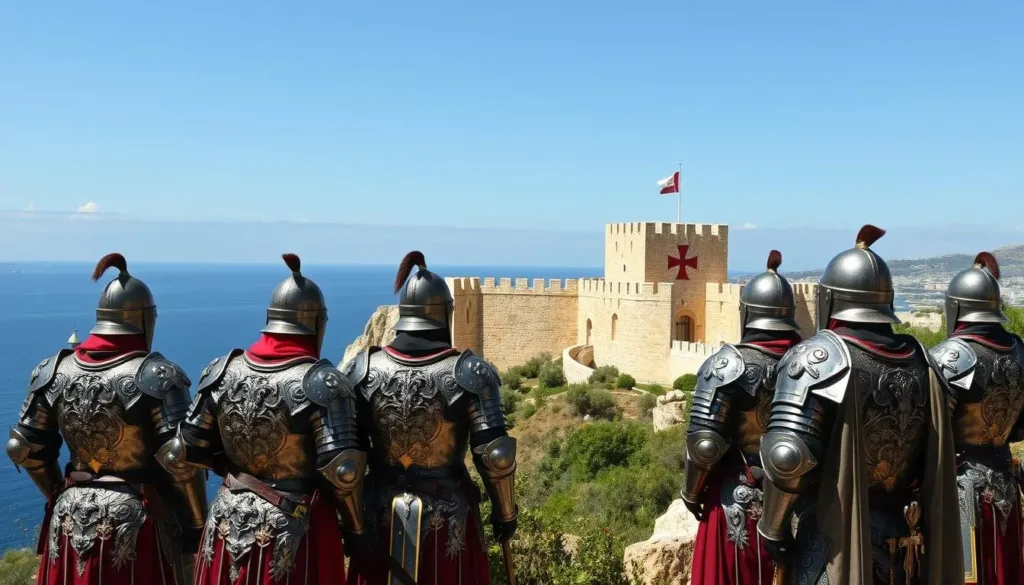
A group of armored knights in elaborately detailed historical attire, standing guard at a majestic stone fortress overlooking the Mediterranean Sea, with the iconic red and white Maltese cross symbol prominently displayed, surrounded by lush greenery and a clear blue sky in the With the famous red and white Maltese cross sign clearly displayed, a group of armored knights dressed in intricately crafted historical garb stand watch at a regal stone fortress with a clear blue sky and lush foliage in the background..
“The Knights of Malta were the guardians of the Mediterranean, defending the island with unwavering courage and determination.”
British Colonial Influence on Modern Malta
Malta has a long history with the British Empire. British sovereignty over Malta lasted from 1800 to 1964. The nation’s culture and civilization have been impacted by this time period for a long time. The legacy of Malta’s independence from the British Empire still has an intriguing impact on the nation today.
A substantial British influence can be seen in the Maltese language. Many English words have been borrowed into Maltese, a Semitic language. In business, technology, and contemporary life, this is particularly true. It demonstrates how the British influenced Malta’s social and economic development.
The architecture and infrastructure of Malta have also been impacted by the British. The colonial period saw the construction of numerous structures and roadways. The pragmatic approach of the British Empire is reflected in them. Like in the UK, this driving style is still prevalent in Malta today.
| British Influence in Malta | Impact |
|---|---|
| Language | Incorporation of English loanwords, particularly in business and technology |
| Infrastructure and Architecture | Roads, buildings, and driving habits reflecting the functional style of the British Empire |
| Cultural Traditions | Adoption of British customs and festivals, such as afternoon tea and Christmas celebrations |
Additionally, Malta incorporated British cultural traditions and customs. The island has a large Christmas celebration and a fondness for afternoon tea. These are instances of how British customs have influenced Maltese culture.
The effects of Malta’s colonial heritage are still felt as it commemorates its independence from the British Empire. An important aspect of contemporary Maltese life is the British influence. It demonstrates the nation’s historical development.
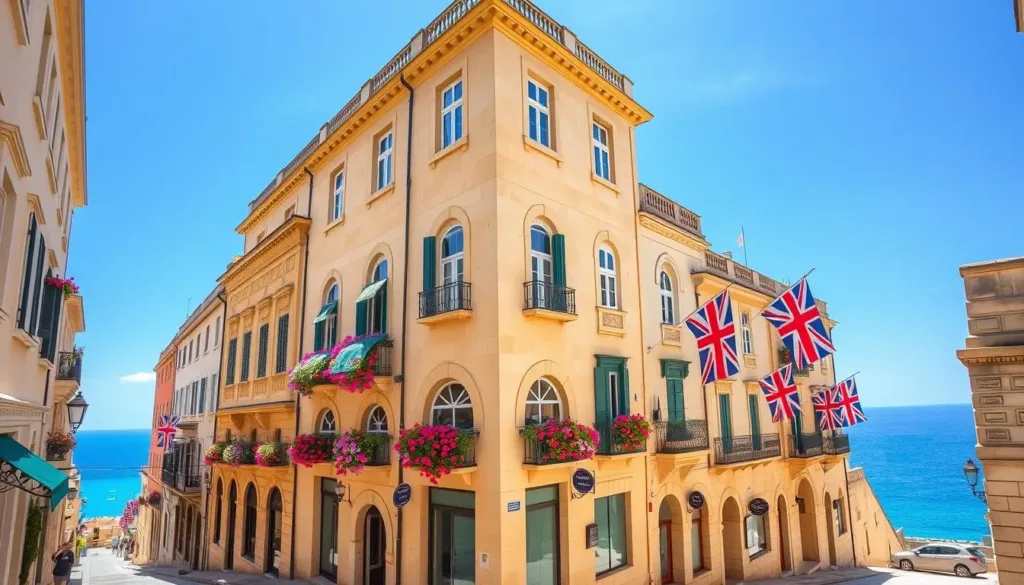
Beautiful Maltese street scene with British colonial architecture, including arched-windowed stone buildings, colorful flower boxes, and British flags waving in the air. The sky is bright blue, and the Mediterranean Sea is azure in the distance.
Valletta: Europe’s Smallest Capital City
In the Mediterranean, Valletta is a shining example. It is a treasure for Malta and all of Europe. Valletta, the capital of Malta, is Europe’s smallest capital. However, it has a big impact.
Baroque Architecture
The buildings in Valletta are a sight to behold. A testament to its cultural and historical significance is its UNESCO World Heritage designation. Baroque masterpieces abound throughout the city’s streets, showcasing both the heritage of the Knights of St. John and its rich history.
Examples include the Grand Master’s Palace and St. John’s Co-Cathedral. Today, the residents of Valletta take pleasure in these structures.
Modern City Life
The Grand Master’s Palace and St. John’s Co-Cathedral are two examples. These buildings are now enjoyed by Valletta’s citizens.
It is essential to explore the lanes or stroll down Strait Street. The views from the Upper Barrakka Gardens are breathtaking. The city of Valletta offers a distinctive experience by fusing the past and present of Malta.
Islands and Natural Wonders of Malta
As I explore the Maltese archipelago, I’m struck by how beautiful the natural surroundings are. Comino and Gozo are two islands that highlight Malta’s wild side. Their breathtaking coasts and crystal-clear waters are a visual feast.
The heart of the Mediterranean Sea is home to the Maltese islands. For people who enjoy nature and the great outdoors, they are ideal.
My attraction to Gozo is its serene atmosphere and untamed beauty. I am amazed by the Ġgantija Temples and the Azure Window. The island’s distinctive locations, such as Fungus Rock and the Inland Sea, are stunning.
I then travel to Comino, where the Blue Lagoon is waiting for me. For swimmers and snorkelers, this blue paradise is a sanctuary. A tranquil haven from the outside world, it displays the splendor of the Mediterranean.




Informative
Very informative